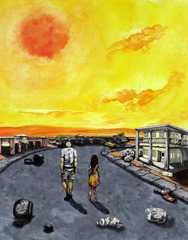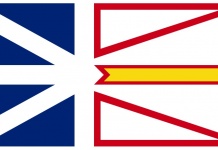 A new sci-fi novel coming out in September depicts a future some 150 years from now when Alaska has become part of Canada. The Lower 48 States no longer exist as a geopolitical entity. Imagine that!
A new sci-fi novel coming out in September depicts a future some 150 years from now when Alaska has become part of Canada. The Lower 48 States no longer exist as a geopolitical entity. Imagine that!
When I spoke to my law professor friend Edward L. Rubin earlier in the year about the hybrid sci-fi/cli-fi novel he was writing titled “The Heatstroke Line,” he told me an interesting story about the plot he had devised. Rubin, a good-natured academic in his mid-60s who lives in Nashville where he teaches at Vanderbilt University Law School, has always been passionately interested in issues such as social justice and human rights, as well as the environment and law.
This summer he traded in his academic hat temporarily for a novelist’s cap. The result is a story set in the near future when Canada has assumed control of North America, taking Alaska into its fold and hauling tons of Midwest soil over the old border to use for agriculture in what is now a very temperate and warmed over Canada.
Meanwhile much of the U.S. is hot enough to justify the title of the book and of Philadelphia artist Emma Podietz’s powerful illustration for the cover. Sounds implausible? That’s the nature of fiction, and Rubin told me he wanted to shake things up a bit with a plot that would be sure to captivate Canadian readers and perhaps prod American readers to think harder about global warming issues before it’s too late.
The book will be published as an ebook book and paperback by Sunbury Press in September. As a friend of the author and with his permission, I am currently willing to send a free electronic copy of the 75,000 word novel to any TeleRead community member who requests one, no strings attached and no blurbs or reviews needed. Just email my home office address of bikolang@gmail.com (it means “American person” in Chinese). The offer is good for the next 30 days. Please, the copy will be only for your personal use or your family’s. It will be in nonDRMed Word, which you’re free to convert into ePub, Kindle or any other format.
Now, back to the plot The story takes place in the future when global warming has made much of the Earth uninhabitable, Rubin told me in a recent email. “But the result isn’t some ‘Mad Max’ wasteland. Instead, the U.S., suffering from the heat, has broken apart into three small, weakened nations which are all dominated by Canada, which has taken over Alaska and New England and transported the topsoil from the American Midwest to Canada’s newly temperate arctic regions.”
The American South has become so hot that it is barely inhabitable, especially below the so-called “heatstroke line,” which is basically the old border line between the North and the South in the U.S. Civil War of the 1860s. In addition, the South is afflicted by savage, flesh-eating bugs called “biter bugs” that have developed as a result of the climate change, Rubin said in describing his science fictional plot to me.
Rubin told me he wrote the hybrid-genre novel partly as entertainment and partly as a wake up call for climate denialists.
“Why are so many people prepared to jump on the denial bandwagon?” Rubin said. “One answer might be that government officials in Canada and America cannot face the possibility of nationwide or worldwide disasters. Proponents of global warming, it could be argued, have predicted a future that is just too grim to contemplate.”
But Rubin said he didn’t create the plot to irritate Alaskans or Canadians .
“The geopolitical elements of the story just came to me, and I wrote it down that way,” he told me.
Some quotes from the novel shed some light on the friction that develops in the novel between Canada and the former Lower 48 states which are now divided into three separate, desperate regions.
One character in the book says to a lab colleague: “It took three years for them to transport all that Midwest topsoil to Canada, even with those giant trains. Just think, three years of ripping the surface off seven states.”
“Well, we did drop nuclear bombs on two of their largest Canadian cities,” says the colleague in return.
While Rubin’s hybrid sci-fi/cli-fi novel is just fiction, the story might serve to re-align the way readers currently see geopolitics in North America, even today.
Dan Bloom blogs at The Cli-Fi Report at cli-fi.net. The cover illustration, “The Heatstroke Line,” is ©2015 by Emma Podietz.
































